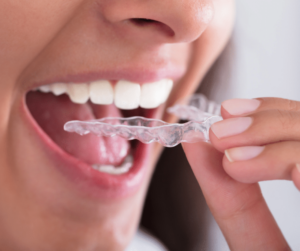Are you considering orthodontic treatment to straighten your teeth but don’t like the idea of traditional braces or plastic aligners? Lingual braces might be an option for you. Lingual braces offer a discrete alternative to other forms of orthodontic treatment. What sets lingual braces apart is in their placement on the back of the teeth.
Why lingual braces?
Patients have many reasons to forgo the traditional braces route. They might be in a professional position and feel braces are too distracting. Or, some adults think they look immature with metal brackets bedazzling their smile. Plastic aligners are a better cosmetic option but they also aren’t for everyone. The idea of removing the aligners and the process of switching them out bothers some people.
If you’re looking for the cosmetic advantages of plastic aligners and the permanence of traditional braces O’Neill Orthodontics has the perfect solution for you. Lingual braces offer the best of both worlds.
There is a growing interest in lingual braces because of these great features, although not every practice offers them. Placement requires additional training and experience. At O’Neill Orthodontics, Dr. O’Neill has the advanced education and experience necessary to treat you with lingual braces.
Treatment with lingual braces
Essentially, lingual braces are like traditional braces but they are placed behind the teeth in order to hide them. The inside or reverse side of teeth are referred to by orthodontists as the lingual side, hence the name. They are also sometimes called “inside braces.”
Lingual braces can correct many of the same problems including misalignments, closing gaps, as well as most orthodontic problems. People who play sports or a wind instrument opt for lingual braces because their placement will not interfere with performance.
The process is also very similar to traditional braces. We take a scan or impression and use that detailed cast to custom brackets for your teeth. We then bond the brackets to the lingual side and then place the wires.
Your lingual braces are permanent but not visible.
Caring for your lingual braces
Cleaning your teeth with lingual braces is just as important as traditional braces. We recommend you brush twice a day with a soft-bristle toothbrush. Floss at least once a day. You can also use a water irrigation device (water floss) to flush between brackets and your teeth. Keep up on your regular dental cleanings as well.
Your food choices are also similar to regular braces. Foods that are too sticky or chewie and too hard or crunchy can damage your braces or cause them to become loose, lengthening treatment time.
Are lingual braces right for me?
Lingual braces are not for everyone or for every situation. Dr. O’Neill will help you decide if lingual braces are the right choice. She will explain your options and how they differ from both traditional braces and plastic aligners.
Contact O’Neill Orthodontics today for a consultation to find out more about lingual braces and whether they are a good esthetic option for you.
Our unique office is located in New Freedom, PA – we’re an easy drive for all our PA and Maryland patients and provide top-notch care in a sophisticated, tech-savvy office. Dr. Nancy O’Neill is a Board Certified Orthodontist and a graduate of the University of Maryland. If you’re looking for excellence, you’re looking for O’Neill Orthodontics.
Click below to make a complimentary consultation appointment. We can’t wait to meet you.
*Note: While Dr. O’Neill can spot airway obstruction, she will always refer your teen to a specialist to diagnose. If diagnosed with Sleep Apnea or Airway Obstruction, Dr. O’Neill is certified and an expert with treatment!













